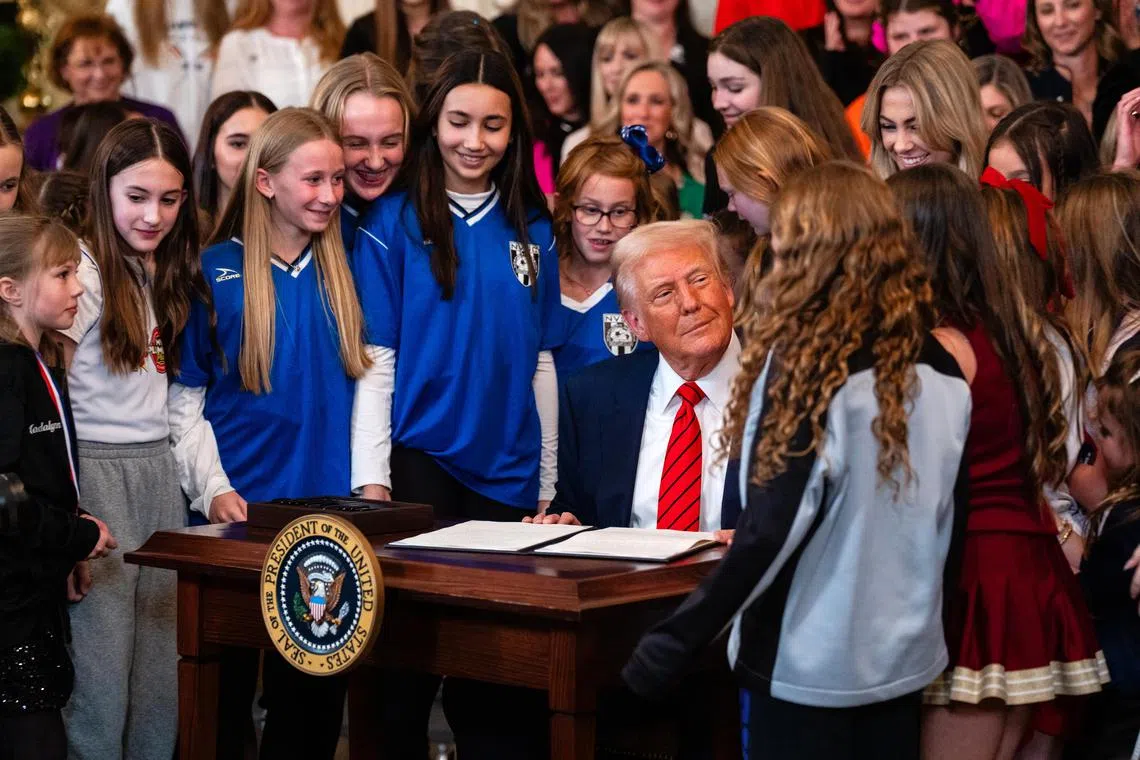US Olympic officials bar transgender women from women’s competitions
Sign up now: Get ST's newsletters delivered to your inbox

US President Donald Trump invites young female athletes as he signs No Men in Women's Sports Executive Order on Feb 5.
PHOTO: ERIC LEE/NYTIMES
Juliet Macur
Follow topic:
NEW YORK – The United States Olympic & Paralympic Committee (USOPC) quietly changed its eligibility rules on July 21 to bar transgender women from competing in Olympic women’s sports, and now will comply with President Donald Trump’s executive order on the issue.
The new policy, expressed in a short, vaguely worded paragraph, is tucked under the category of “USOPC Athlete Safety Policy” on the site, and does not include details of how the ban will work. Nor does the new policy include the word “transgender” or the title of Mr Trump’s executive order, “Keeping Men Out of Women’s Sports”, referring to it instead as “Executive Order 14201”.
The committee’s new policy means that the national governing bodies (NGBs) of sports federations in the United States now must follow the USOPC’s lead, according to several chief executives of sports within the Olympic movement. Those national governing bodies oversee many, but not all, events in Olympic sports for all ages, from youth to masters’ competitions.
In a letter sent by e-mail to the “Team USA Community”, the committee acknowledged on July 22 that its policy had changed. The letter, from Sarah Hirshland, the USOPC’s CEO, and Gene Sykes, the president, said the committee had held “a series of respectful and constructive conversations with federal officials” since the executive order was signed.
“As a federally chartered organisation, we have an obligation to comply with federal expectations,” the letter said, adding that the committee would work with the national governing bodies to implement the new policy.
USA Fencing was among the first of the national governing bodies to post a new policy for transgender athletes. Its new policy will take effect on Aug 1.
Those new rules still allow transgender women to compete, but only in the men’s category.
The rule changes come after the sport was thrust into an uncomfortable spotlight in 2025 when a female fencer declined to compete against her transgender opponent at a mid-level meet. The moment went viral and led to a congressional hearing about transgender women competing in women’s sports.
“I’m not going to try to oppose the USOPC because I understand that they’ve been put in an impossible situation by the administration,” said Phil Andrews, CEO of USA Fencing.
“We essentially have no choice but to change the rules because once the USOPC says, ‘This is now the policy of all of our NGBs’, we all have to follow it.”
Andrews added that it was unclear how the new policy would play out in states such as Minnesota and California, which are defying Mr Trump’s ban on transgender women competing in the women’s category.
How the entire policy will unfold, from sport to sport, and state to state, is uncertain, too.
Some sports could add an “open” category, available to anyone, or a mixed gender category to accommodate the change, Andrews said.
The USOPC offered little by way of explanation.
Its new policy said that it was “committed to protecting opportunities for athletes participating in sport”, and that it would work with the International Olympic Committee (IOC), the International Paralympic Committee and the national governing bodies of every Olympic sport “to ensure that women have a fair and safe competition environment consistent with Executive Order 14201”.
Before the new “Athlete Safety” policy was posted, the committee had stayed away from taking a bold stance on the issue of transgender women competing in the women’s division, trying to carefully navigate the politics of the matter as the 2028 Olympics in Los Angeles inched closer.
Instead, it had delegated decisions about transgender athlete eligibility to the national governing bodies of each sport. The USOPC has 54 member organisations, according to its website.
The IOC, meanwhile, has been struggling for years with the issue of transgender and intersex athletes in sports, coming up with various rules at various times, in an effort to balance fairness with inclusivity.
Its current policy allows each international sports federation – World Athletics or the International Cycling Union, for example – to determine if, and how, transgender athletes can compete in sanctioned international events.
But several leaders in the Olympic movement said on July 22 that they were expecting the IOC’s rules for transgender athletes to change now that the organisation had a new leader, Kirsty Coventry.
During her campaign for president, Coventry had pledged to protect women in sports, and that included possibly barring transgender women from competing in the women’s category. NYTIMES

